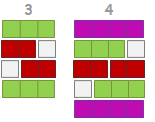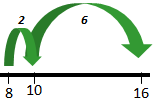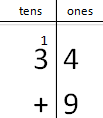You will find printable addition worksheets as well as tables to help your children get extra practice adding numbers. There are also a number of flashcards that you can print out and use when you are tutoring your children and helping them to recall basic addition facts.
The online flashcards randomly present addition questions that your child can click through for additional math practice
The listing of addition and subtraction games provides for some fun adding and subtracting action.
Click the above links or select from the menu to review and use these resources.
What else is in the Addition Section
There are lots more resources and guidance to help with addition and subtraction under the following headings:
 | Ready For Addition and Subtraction? Before starting to memorize facts and solve equations like 5 + 4 = , students should have started to develop their sense of number. Having learned counting numbers and being able to associate these with groups of objects which they can compare using terms like “more”, “less”, “same”, they begin modeling addition and subtraction by manipulating groups of objects; joining them together, taking some away. You will find more on this here. |
 | Number Bonds Number Bonds promote a way of thinking about numbers as being made up of different pairs of components. For example, 5 can be made up of a 1 and a 4, or a 2 and a 3. Thinking of numbers this way, rather than as a grouping of so many ones, helps greatly when developing and applying strategies for mental calculation. There is more on number bonds here. |
 | Making 10 Strategy One of the first encounters students have with numbers above 10 is when they try to add two single-digit numbers. This is often the first time they have to deal with our place value system. It can be a big step from adding 7 + 2 to solving 7 + 5 and making this step requires strategies such as making 10. You will find more on this very important step here. |
 | Word Problems 14 different types of addition and subtraction situations are described together with the importance to students of understanding their meaning in terms of the addition or subtraction operations required. Click here for more. |
 | Algorithmic Method Algorithms for adding and subtracting numbers are shown. These require an understanding of place value and a brief recap on this is included. There are two step-through lessons to follow as well as links to worksheets and worksheet generators for limitless practice questions. Click here for more. |
Assumptions To Watch Out For
- Do not assume that your children know to read “+” as plus or add. Similarly ensure they are confident in their understanding of the minus (“ – “) symbol.
- Do not assume that because your children can solve 7 + 8 = in the horizontal format, they automatically can solve the same addition when it is formatted vertically.
- Do not assume that your children find adding or subtracting zero as being obvious. This is especially true for those who have experience with multiplication where the operation with zero results in an answer of zero.